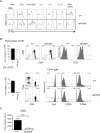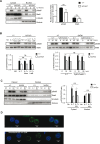TCR and IL-7 Signaling Are Altered in the Absence of Functional GTPase of the Immune Associated Nucleotide Binding Protein 5 (GIMAP5)
- PMID: 27023180
- PMCID: PMC4811415
- DOI: 10.1371/journal.pone.0151837
TCR and IL-7 Signaling Are Altered in the Absence of Functional GTPase of the Immune Associated Nucleotide Binding Protein 5 (GIMAP5)
Abstract
GTPase of the immune associated nucleotide binding protein (GIMAP) family of proteins are expressed essentially in cells of the hematopoietic system. Mutation in the founding member of this gene family, Gimap5, results in the lymphopenic phenotype in Bio-Breeding diabetes prone rats. In mice, deletion of functional Gimap5 gene affects the survival and renewal of hematopoietic stem cells in addition to the defects observed in T cells. Here we show that T cells from OTII TCR-transgenic Gimap5sph/sph mice do not proliferate in response to its cognate antigen. Furthermore, T cells from Gimap5 mutant rats and mice show decreased phosphorylation of STAT5 following stimulation with IL-7. Our results suggest that functional Gimap5 is required for optimal signaling through TCR and IL-7R in T cells.
Conflict of interest statement
Figures





Similar articles
-
The GIMAP Family Proteins: An Incomplete Puzzle.Front Immunol. 2021 May 31;12:679739. doi: 10.3389/fimmu.2021.679739. eCollection 2021. Front Immunol. 2021. PMID: 34135906 Free PMC article. Review.
-
Loss of T cell and B cell quiescence precedes the onset of microbial flora-dependent wasting disease and intestinal inflammation in Gimap5-deficient mice.J Immunol. 2010 Apr 1;184(7):3743-54. doi: 10.4049/jimmunol.0903164. Epub 2010 Feb 26. J Immunol. 2010. PMID: 20190135 Free PMC article.
-
Gimap5-dependent inactivation of GSK3β is required for CD4+ T cell homeostasis and prevention of immune pathology.Nat Commun. 2018 Jan 30;9(1):430. doi: 10.1038/s41467-018-02897-7. Nat Commun. 2018. PMID: 29382851 Free PMC article.
-
Gimap3 and Gimap5 cooperate to maintain T-cell numbers in the mouse.Eur J Immunol. 2014 Feb;44(2):561-72. doi: 10.1002/eji.201343750. Epub 2013 Oct 23. Eur J Immunol. 2014. PMID: 24510501
-
Central role of gimap5 in maintaining peripheral tolerance and T cell homeostasis in the gut.Mediators Inflamm. 2015;2015:436017. doi: 10.1155/2015/436017. Epub 2015 Apr 7. Mediators Inflamm. 2015. PMID: 25944983 Free PMC article. Review.
Cited by
-
The GIMAP Family Proteins: An Incomplete Puzzle.Front Immunol. 2021 May 31;12:679739. doi: 10.3389/fimmu.2021.679739. eCollection 2021. Front Immunol. 2021. PMID: 34135906 Free PMC article. Review.
-
Loss of GTPase of immunity-associated protein 5 (Gimap5) promotes pathogenic CD4+ T-cell development and allergic airway disease.J Allergy Clin Immunol. 2019 Jan;143(1):245-257.e6. doi: 10.1016/j.jaci.2018.10.018. Epub 2018 Oct 25. J Allergy Clin Immunol. 2019. PMID: 30616774 Free PMC article.
-
Exploring the expression and preliminary function of chicken Gimap5 gene.PeerJ. 2019 Sep 26;7:e7618. doi: 10.7717/peerj.7618. eCollection 2019. PeerJ. 2019. PMID: 31579581 Free PMC article.
-
GTPase of the Immune-Associated Nucleotide Protein 5 Regulates the Lysosomal Calcium Compartment in T Lymphocytes.Front Immunol. 2017 Feb 7;8:94. doi: 10.3389/fimmu.2017.00094. eCollection 2017. Front Immunol. 2017. PMID: 28223986 Free PMC article.
-
Egyptian Rousette IFN-ω Subtypes Elicit Distinct Antiviral Effects and Transcriptional Responses in Conspecific Cells.Front Immunol. 2020 Mar 13;11:435. doi: 10.3389/fimmu.2020.00435. eCollection 2020. Front Immunol. 2020. PMID: 32231668 Free PMC article.
References
-
- Hornum L, Romer J, Markholst H. The diabetes-prone BB rat carries a frameshift mutation in Ian4, a positional candidate of Iddm1. Diabetes. 2002;51(6):1972–9. . - PubMed
Publication types
MeSH terms
Substances
Grants and funding
LinkOut - more resources
Full Text Sources
Other Literature Sources
Molecular Biology Databases
Miscellaneous

